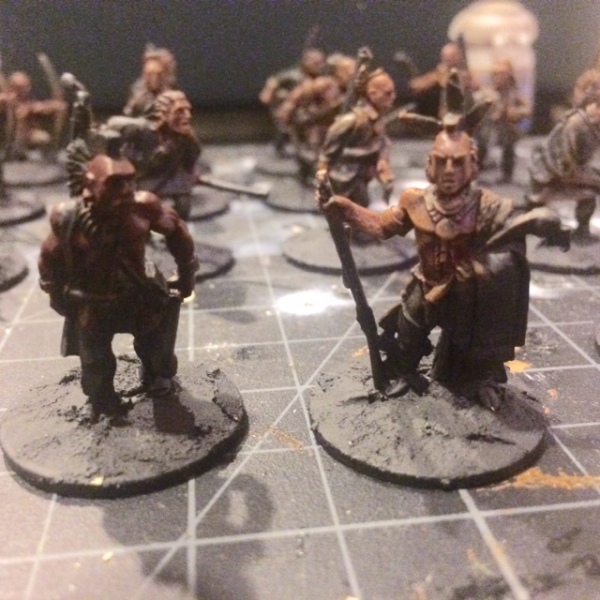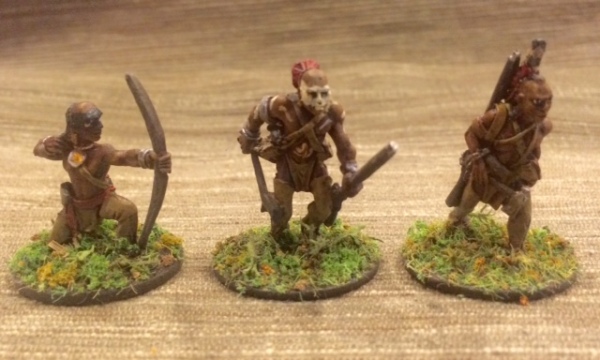After facing my fear of painting all the details on my first 18th-century British Redcoats, I turned next to North American Indians and another challenge – painting lots of flesh. Getting Indians in the mix with my
French and Indian War gaming project was key, and my focus on the era of the
Braddock Expedition and the
Battle of the Monongahela meant I was going to need lots of Indians. In addition and since both the British and the French allied with different tribes throughout the war, I was going to need a fair amount of variety from the figures I chose.
As I entered into modelling my first North American Indians of the 18th-century, I went to two books. Jill Lepore’s The Name of War: King Philip’s War and the Origins of American Identity (1998) focuses on how warfare in New England in the 1670s shaped the mindsets of European settlers as well the native people they encountered. In a follow-up of sorts, Our Savage Neighbors: How Indian War Transformed Early America (2007) by Peter Silver picks up this thread in the Mid-Atlantic colonies of the 1700s as multiple nationalities and ethnicities of Europeans again ran up against a population of natives set on halting the expansion of these new arrivals. Both books are remarkable and still ring as relevant to this day as fear and violence remain a cultural and poltical driver as we Americans continue to grapple with new cultures of people looking to share space.


With a bit of reading under my belt, I was fortunate to have a fellow member at
Metropolitan Wargamers in Brooklyn, NY who had piles of extra Indians from
Conquest Miniatures sitting in a box. These metal cast models are now carried by
Warlord Games in both boxed sets like the
Woodland Indian War Party and in smaller packages. From my friend’s stash and without duplicating poses, I was able to pull out a couple dozen different models to build my initial Indian force. The models show a lot of unique personality and equipment with both traditional weapons (bows, war clubs, knives and hatchets) and European guns. The mode of dress also varies, with some figures wearing only the minimum of a loincloth and leggings while others are in long-sleeved shirts.
My first Indians get their base flesh coat
As per my usual process at this scale, all the metal was cleaned up, the figures were based on washers and the bases were filled in roughly with wood putty. After a black spray coat, the first challenge was in finding a proper flesh tone to represent Native woodland Indians of northeastern North America. I read a lot online debate on how to capture the skin tone of a varied people, so I settled on a two-part process of my own.
A second lighter flesh coat is added
Over the black primer I applied a first coat to exposed skin areas using a 50/50 mix of red and dark brown paints. As the paint was drying, I immediately noticed the skin was a good dark color but translating as overly red even at arm’s length. In order to preserve the richness of the color while also tempering the bright redness, I gently dry brushed a coat of light brown over all the skin areas again. Once dried a second time, I felt I had a fairly decent tabletop rendition of skin tone capturing the creases, shadows and shape of the bared muscles without tipping into caricature.
Details in equipment and clothing begin to be blocked out
As opposed to the sameness of European uniforms of the FIW period, the real fun in painting these Indian models is in the imagination that can be put into them. Not surprisingly, there’s not much of a detailed historic visual record of exact modes of dress for Native Americans of this period. With that, I let my creativity reign. Most leggings, loincloths and satchels got a basic leather brown color with fringe highlighted in slightly lighter brown. Jewelry such as necklaces, earrings and bracelets got a mix of metallic and red, blue or green colors to represent precious stones or trade beads.
Since decoration was very prominent with most tribes of the Northeast, all bags, leggings, belts and other gear got a mix of geometric patterns applied to represent this native craftsmanship. Detail also extended to some of the flesh on the models, with most receiving body paints or tattoos in red, dark blue, black and white. In the end some of the figures wound up with their arms, heads or even entire torsos covered in paint.
Painted models are finished off in a woodland-like basing mix
While half the models carried the look of their native cultures, the other models sported more European-style clothing with long shirts, blankets and leggings, all of which were done in various colors. I especially liked one figure who seems to be striding along proudly wearing a captured British red coat. With everything painted, the bases were finished with
Green Adirondack ground cover from
Scenic Express.
My first two dozen completed Indians wound up dividing nicely into two groups of twelve. This will make them easier to identify as diffrent units on the same side or different tribes altogther choosing to swing their aliance to the opposing British and French.
















